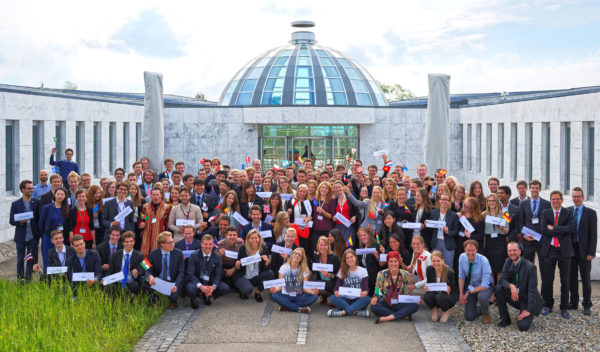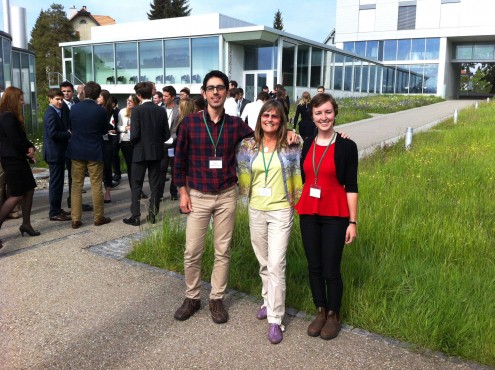
Attendees of the United Nations Framework Convention on Climate Change (UNFCCC) Strategy Role Play in St. Gallen, Switzerland. Photo provided.
In May 2015, I had the pleasure of attending a model United Nations Framework Convention on Climate Change (UNFCCC) Strategy Role Play in St. Gallen, Switzerland, organized by the Global Alliance in Management Education (CEMS). Held at the Executive Campus of St. Gallen University, perched on a picturesque hilltop overlooking a meadow filled with wildflowers, the model negotiations were intended to broaden students’ understanding of climate change and climate policy. I attended the conference with another UVic student, Babak Manouchehri, who is completing his PhD in the Electrical and Computer Engineering department, and Dr. Monika Winn, a professor from the Gustavson School of Business. Babak and I were selected by the Graduate Students’ Society (GSS) to represent UVic at the conference. The trip was made possible by Dr. Monika Winn and the Centre for Social and Sustainable Innovation (CSSI), part of UVic’s Gustavson School of Business.
The model UNFCCC brought together a group of Master’s students and professors from leading business schools across Europe. The Strategy Role Play was the culmination of a climate change policy course completed by the students prior to the model negotiation. More than 120 delegates took part in the conference and each student was assigned a role as a hypothetical government representative, an N.G.O. representative, an industry lobbyist, or a member of the Media Team.
We were originally supposed to attend the conference as observers, but were fortunate enough to join the Media Team. This allowed us to play a much more active role in the conference. The Media Team was responsible for all official reporting, interviewing, and photography for the conference, as well as the maintenance of a Model UNFCCC blog and Facebook page, which were widely used amongst delegates to stay up-to-date with the fast-paced negotiations. The other delegates were also able to “use” the Media Team to their advantage in order to put pressure on other countries. The importance and reliance on the Media Team during the negotiations reflects what we believe to be the importance of the media and social media in present-day negotiations.
The first day of the negotiation began with a plenary session (which all of the delegates were present at) and each delegate made a short formal opening statement. This provided everyone with an indication of parties’ standpoints on key issues. After the opening session, the fast-paced workshops began and continued throughout the day. The workshops covered three main agenda items: mitigation, adaptation, and emissions trading (which particularly focused on the Reducing Emissions from Deforestation and Forest Degradation (REDD) mechanism). As part of the Media Team, we were each responsible for reporting on a specific workshop and updating the media blog and Facebook group accordingly. It was important to be concise while reporting and to make sure that everything we were reporting was factually accurate. Delegates made decisions on key issues based partly on information posted on the media sites, so it was crucial to provide accurate information.
There were also events hosted by NGO and industry group representatives. These events were key for networking, collaborating, and forming coalitions. It seems as though most of the informal settings were where many of the important decisions and strategies were made.
The three main workshop topics of the model negotiations (mitigation, adaptation, and trading) match the structure of the upcoming Conference of the Parties (COP21) that will take place in Paris this December. COP21 is the “real” version of the UNFCCC Strategy Role Play that we attended. This year’s UNFCCC COP21 will be an important conference, with the goal of implementing a new international agreement on climate change that will aim to keep global warming levels below two degrees Celsius. Decisions at a COP can only be reached by consensus, which was also the only way to reach decisions during the UNFCCC Strategy Role Play.
The UNFCCC Strategy Role Play was an excellent way for us to learn about how climate change policy is discussed, agreed upon, and ultimately brought to action. Participating in a model negotiation provided us with a strong sense of just how challenging it can be to reach consensus among countries with differing worldviews and strategic interests. It was interesting to see how different power relations come into play during the model negotiations, which we believe is an accurate depiction of what a true climate change negotiation would look like in the “real world.”
During the model negotiations, one way that countries attempted to minimize the impact of power relations from specific countries was to create coalitions. The main coalition that was created during the model negotiation was the Coalition of Most Affected Countries (COMAC), which represented more than 16 developing countries. The COMAC was created during the opening plenary dinner on the evening before the model negotiation began. The development of the COMAC at the plenary dinner truly made the conference feel like a real negotiation from the beginning, because every conversation was regarded as an opportunity to negotiate, leverage one’s position, and strategize towards fulfilling one country’s interests, all to achieve an overall resolution.
Attending the UNFCCC 2015 Model Negotiations was a whirlwind trip, but the real work has only just begun for us. We are currently writing several articles and reports about our experience, and we also plan on meeting with UVic faculty, staff, and the greater community in order increase climate change awareness and action at UVic. Babak and I feel very fortunate to have been able to attend the model UNFCCC negotiation in Switzerland. We also appreciated getting to experience the rich Swiss culture (and of course, Swiss chocolate), during our action-packed trip! Our hope and goal is that sharing our experience will encourage others to get involved in the fight against climate change.
[gview file=”https://martlet.ca/martlet.ca/uploads/2014/10/Web_FeatureSpread.pdf”]









